2022 TOYOTA SIENNA HYBRID brake sensor
[x] Cancel search: brake sensorPage 43 of 600

431-1. For safe use
1
For safety and security
Side impact sensors (rear)
Driver’s seat belt buckle switch
Driver’s seat position sensor
Driver airbag
Front passenger occupant classification sensors
Driver’s knee airbag
SRS warning light
Airbag sensor assembly
Your vehicle is equipped with ADVANCED AIRBAGS designed
based on the US motor vehicle safety standards (FMVSS208). The
airbag sensor assembly (ECU) cont rols airbag deployment based on
information obtained from the sensors etc. shown in the system
components diagram above. This in formation includes crash sever-
ity and occupant information. As the airbags deploy, a chemical
reaction in the inflators quickly fills the airbags with non-toxic gas to
help restrain the motion of the occupants.
■If the SRS airbags deploy
(inflate)
●Slight abrasions, burns, bruising
etc., may be sustained from SRS
airbags, due to the extremely high
speed deployment (inflation) by
hot gases.
●A loud noise and white powder will
be emitted.
●Parts of the airbag module (steer-
ing wheel hub, airbag cover and
inflator) as well as the front seats,
parts of the front and rear pillars,
and roof side rails, may be hot for
several minutes. T he airbag itself
may also be hot.
●The windshield may crack.
●The hybrid system will be stopped
and fuel supply to the engine will
be stopped. ( P.86)
●All of the doors will be unlocked.
( P.134)
●The brakes and st op lights will be
controlled automatically. (
P.335)
●The interior lights will turn on auto-
matically. ( P.365)
●The emergency flashers will turn
on automatically. ( P.456)
●For Safety Connect subscribers, if
any of the following situations
occur, the system is designed to
send an emergency call to the
response center, notifying them of
the vehicle’s location (without
needing to push the “SOS” button)
and an agent will attempt to speak
with the occupants to ascertain
the level of emergency and assis-
tance required. If the occupants
are unable to communicate, the
agent automatically treats the call
as an emergency and helps to dis-
patch the necessary emergency
services. ( P.75)
• An SRS airbag is deployed.
• A seat belt pretensioner is acti- vated.
• The vehicle is involved in a severe rear-end collision.
L
M
N
O
P
Q
R
S
Page 144 of 600
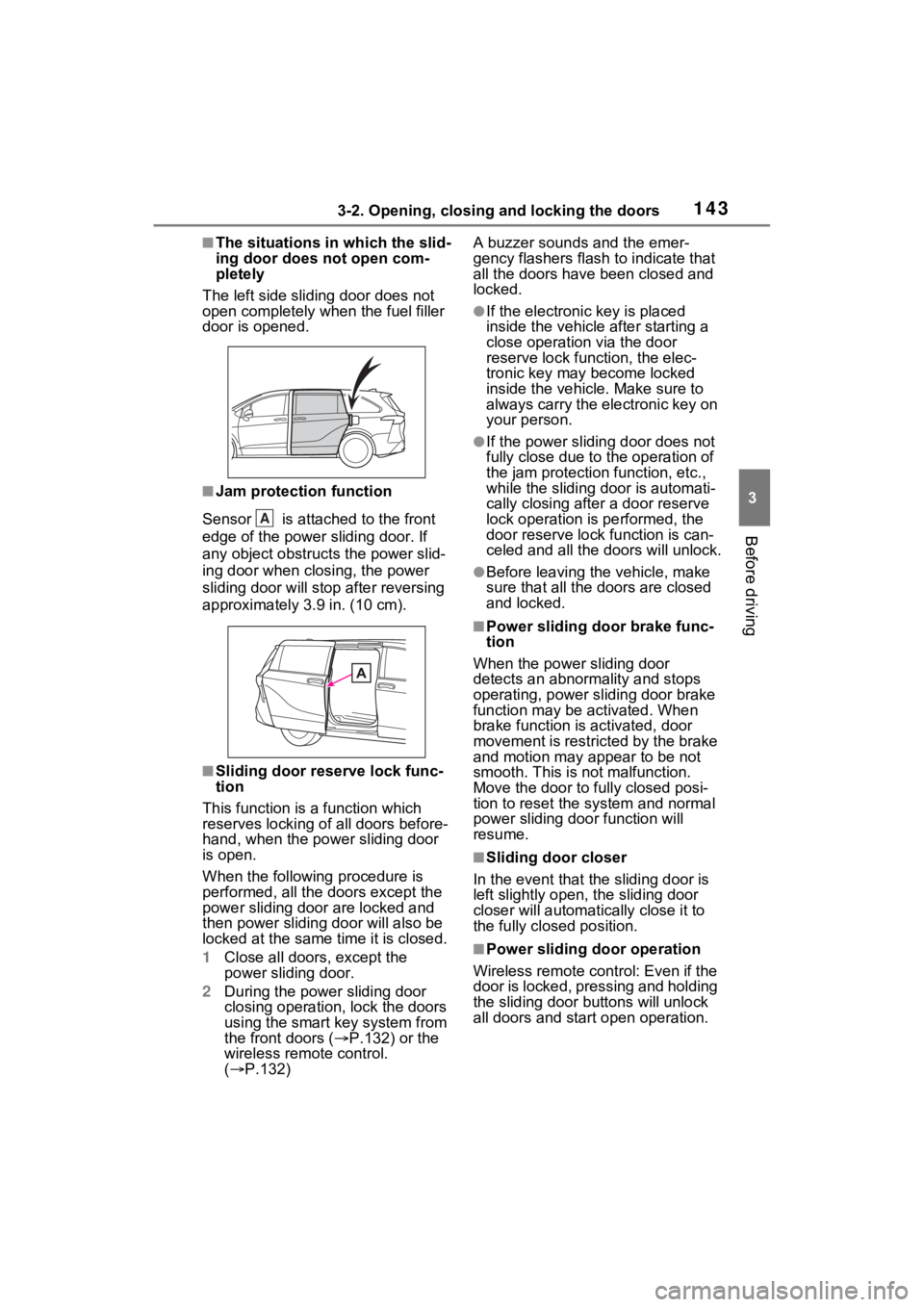
1433-2. Opening, closing and locking the doors
3
Before driving
■The situations in which the slid-
ing door does not open com-
pletely
The left side sliding door does not
open completely when the fuel filler
door is opened.
■Jam protection function
Sensor is attached to the front
edge of the power sliding door. If
any object obstructs the power slid-
ing door when cl osing, the power
sliding door will stop after reversing
approximately 3.9 in. (10 cm).
■Sliding door reserve lock func-
tion
This function is a function which
reserves locking of all doors before-
hand, when the power sliding door
is open.
When the following procedure is
performed, all the doors except the
power sliding door are locked and
then power sliding door will also be
locked at the same time it is closed.
1 Close all doors, except the
power sliding door.
2 During the power sliding door
closing operation, lock the doors
using the smart key system from
the front doors ( P.132) or the
wireless remo te control.
( P.132) A buzzer sounds and the emer-
gency flashers flash to indicate that
all the doors have been closed and
locked.
●If the electronic key is placed
inside the vehicle after starting a
close operation via the door
reserve lock function, the elec-
tronic key may become locked
inside the vehicl
e. Make sure to
always carry the electronic key on
your person.
●If the power sliding door does not
fully close due to the operation of
the jam protection function, etc.,
while the sliding door is automati-
cally closing after a door reserve
lock operation is performed, the
door reserve lock function is can-
celed and all the doors will unlock.
●Before leaving the vehicle, make
sure that all the doors are closed
and locked.
■Power sliding door brake func-
tion
When the power sliding door
detects an abnorma lity and stops
operating, power sliding door brake
function may be activated. When
brake function is activated, door
movement is restricted by the brake
and motion may appear to be not
smooth. This is not malfunction.
Move the door to fully closed posi-
tion to reset the system and normal
power sliding doo r function will
resume.
■Sliding door closer
In the event that the sliding door is
left slightly open, the sliding door
closer will automatically close it to
the fully closed position.
■Power sliding door operation
Wireless remote control: Even if the
door is locked, pressing and holding
the sliding door bu ttons will unlock
all doors and start open operation.
A
Page 149 of 600
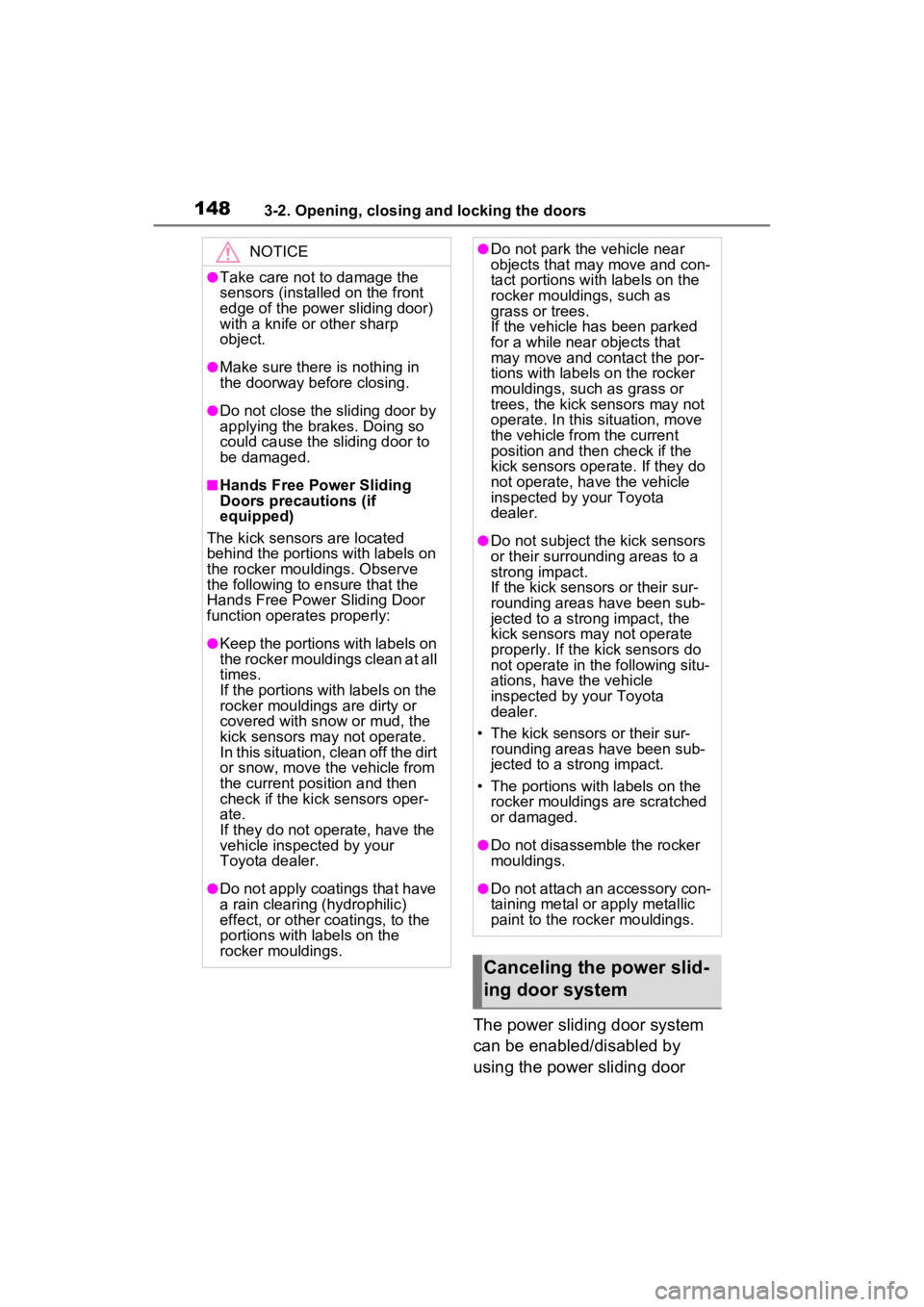
1483-2. Opening, closing and locking the doors
The power sliding door system
can be enabled/disabled by
using the power sliding door
NOTICE
●Take care not to damage the
sensors (installed on the front
edge of the power sliding door)
with a knife or other sharp
object.
●Make sure there is nothing in
the doorway before closing.
●Do not close the sliding door by
applying the brakes. Doing so
could cause the sliding door to
be damaged.
■Hands Free Power Sliding
Doors precautions (if
equipped)
The kick sensors are located
behind the portions with labels on
the rocker mouldings. Observe
the following to e nsure that the
Hands Free Power Sliding Door
function operates properly:
●Keep the portions with labels on
the rocker mouldings clean at all
times.
If the portions with labels on the
rocker mouldings are dirty or
covered with snow or mud, the
kick sensors may not operate.
In this situation, clean off the dirt
or snow, move the vehicle from
the current posi tion and then
check if the ki ck sensors oper-
ate.
If they do not o perate, have the
vehicle inspected by your
Toyota dealer.
●Do not apply coatings that have
a rain cleari ng (hydrophilic)
effect, or other coatings, to the
portions with labels on the
rocker mouldings.
●Do not park the vehicle near
objects that may move and con-
tact portions with labels on the
rocker mouldings, such as
grass or trees.
If the vehicle has been parked
for a while near objects that
may move and contact the por-
tions with labels on the rocker
mouldings, such as grass or
trees, the kick sensors may not
operate. In this situation, move
the vehicle from the current
position and the n check if the
kick sensors operate. If they do
not operate, have the vehicle
inspected by your Toyota
dealer.
●Do not subject the kick sensors
or their surrounding areas to a
strong impact.
If the kick sensors or their sur-
rounding areas have been sub-
jected to a strong impact, the
kick sensors may not operate
properly. If the kick sensors do
not operate in the following situ-
ations, have the vehicle
inspected by your Toyota
dealer.
• The kick sensors or their sur- rounding areas have been sub-
jected to a strong impact.
• The portions with labels on the rocker mouldings are scratched
or damaged.
●Do not disassemble the rocker
mouldings.
●Do not attach an accessory con-
taining metal or apply metallic
paint to the rocker mouldings.
Canceling the power slid-
ing door system
Page 158 of 600

1573-2. Opening, closing and locking the doors
3
Before driving
operates for any of the following
conditions:
• Parking brake is engaged
• The brake pedal is depressed
• The shift lever is in P.
■Operation of the power back
door
●A buzzer sounds and the emer-
gency flashers flash twice to indi-
cate that the back door is
opening/closing.
●When the power back door sys-
tem is disabled, the power back
door does not ope rate but it can
be opened and closed by hand.
●When the power back door auto-
matically opens, if an abnormality
due to people or objects is
detected, oper ation will stop.
■Jam protection function
Sensors are equipped on both sides
of the power back door. If anything
obstructs the power back door while
it is closing, the b ack door will auto-
matically operate in the opposite
direction or stop.
■Fall-down protection function
While the power back door is open-
ing automatically, applying exces-
sive force to it will stop the opening
operation to prevent the power back
door from suddenly shutting.
■Back door reserve lock function
This function is a function which
reserves locking of all doors, before-
hand, when the power back door is
open.
When the following procedure is
performed, all the doors except the
power back door are locked and then power back door will also be
locked at the same time it is closed.
1
Close all doors, except the back
door.
2 During the power back door clos-
ing operation, lock the doors
using the smart key system from
the front doors ( P.132) or the
wireless remote control.
( P.132)
A buzzer sounds and the emer-
gency flashers flash to indicate that
all the doors have been closed and
locked.
●If the electronic key is placed
inside the vehicle after starting a
close operation via the door
reserve lock function, the elec-
tronic key may become locked
inside the vehicle.
●If the power back door does not
fully close due to the operation of
the jam protection function, etc.,
while the back door is automati-
cally closing after a door reserve
lock operation is performed, the
door reserve lock function is can-
celed and all the doors will unlock.
●Before leaving the vehicle, make
sure that all the doors are closed
and locked.
■Close & lock function
When the power ba ck door is open,
this function clos es the power back
door and then locks all of the doors
simultaneously.
When the following procedures are
performed and there are no elec-
tronic keys for the vehicle within the
vehicle, all of the doors will lock
when the power back door is com-
pletely closed.
1 Close all of the doors except the
power back door.
2 While carrying an electronic key,
press the switch twice on the
lower part of the power back
door ( P.154).
A different buzzer than the normal
Page 259 of 600
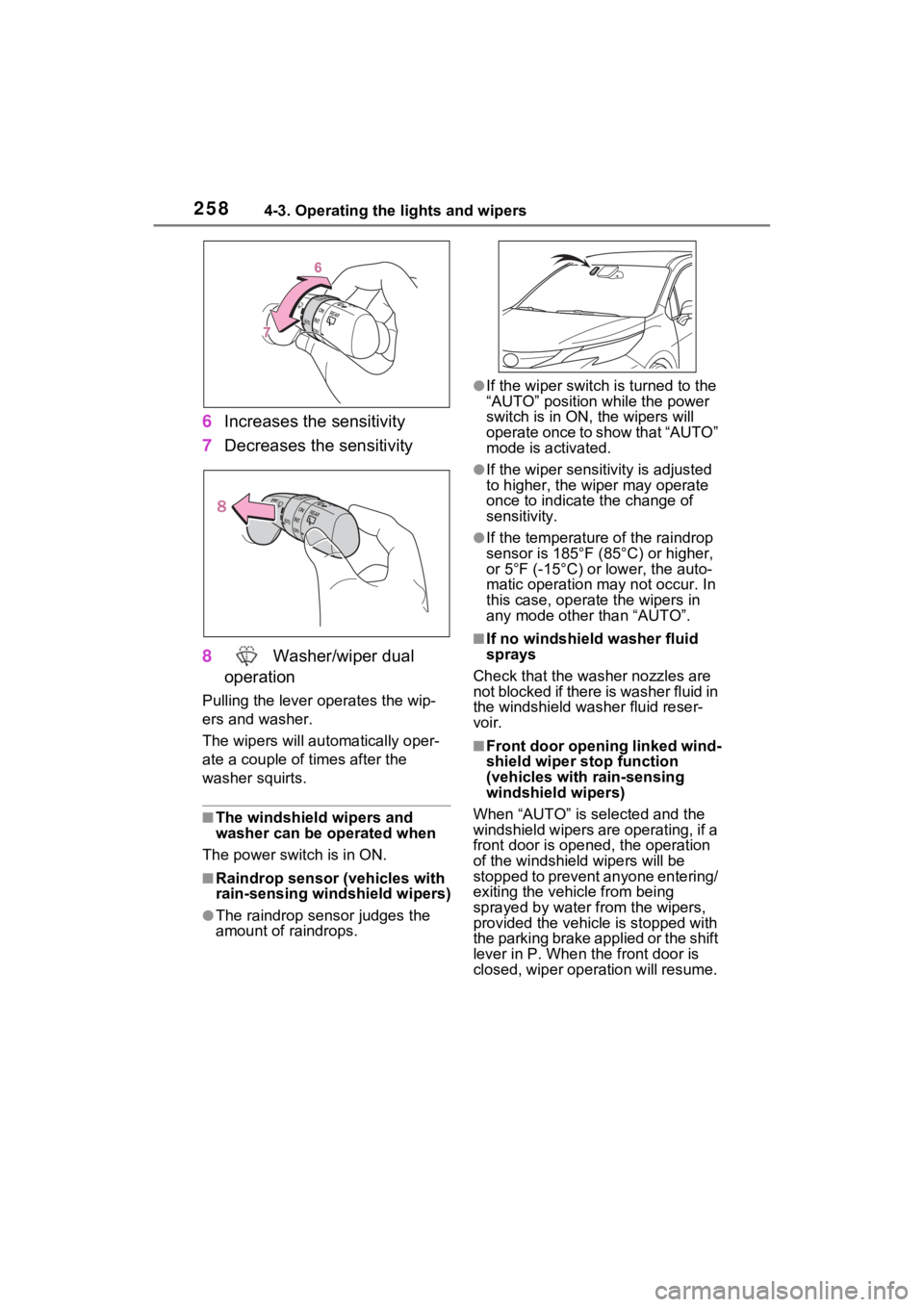
2584-3. Operating the lights and wipers
6Increases the sensitivity
7 Decreases the sensitivity
8 Washer/wiper dual
operation
Pulling the lever o perates the wip-
ers and washer.
The wipers will au tomatically oper-
ate a couple of times after the
washer squirts.
■The windshield wipers and
washer can be operated when
The power swit ch is in ON.
■Raindrop sensor (vehicles with
rain-sensing windshield wipers)
●The raindrop sensor judges the
amount of raindrops.
●If the wiper switch i s turned to the
“AUTO” position while the power
switch is in ON, the wipers will
operate once to show that “AUTO”
mode is activated.
●If the wiper sensitivity is adjusted
to higher, the wiper may operate
once to indicate the change of
sensitivity.
●If the temperature of the raindrop
sensor is 185°F (85°C) or higher,
or 5°F (-15°C) or lower, the auto-
matic operation ma y not occur. In
this case, operate the wipers in
any mode other than “AUTO”.
■If no windshield washer fluid
sprays
Check that the washer nozzles are
not blocked if there is washer fluid in
the windshield washer fluid reser-
voir.
■Front door opening linked wind-
shield wiper stop function
(vehicles with rain-sensing
windshield wipers)
When “AUTO” is selected and the
windshield wipers are operating, if a
front door is open ed, the operation
of the windshield wipers will be
stopped to prevent anyone entering/
exiting the vehicle from being
sprayed by water f rom the wipers,
provided the vehicle is stopped with
the parking brake applied or the shift
lever in P. When t he front door is
closed, wiper operation will resume.
Page 270 of 600
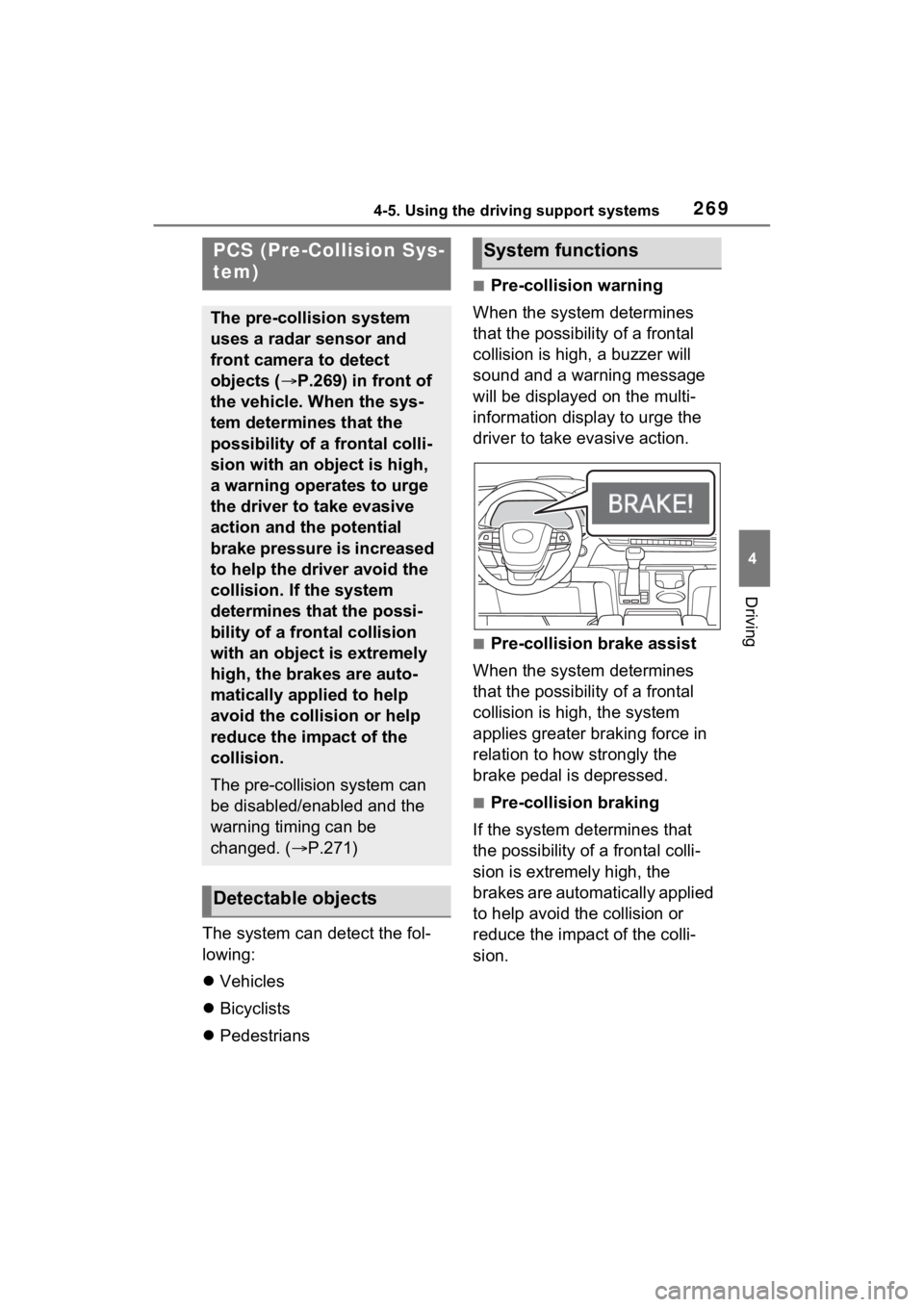
2694-5. Using the driving support systems
4
Driving
The system can detect the fol-
lowing:
Vehicles
Bicyclists
Pedestrians
■Pre-collision warning
When the system determines
that the possibility of a frontal
collision is high, a buzzer will
sound and a warning message
will be displayed on the multi-
information display to urge the
driver to take evasive action.
■Pre-collision brake assist
When the system determines
that the possibility of a frontal
collision is high, the system
applies greater braking force in
relation to how strongly the
brake pedal is depressed.
■Pre-collision braking
If the system determines that
the possibility of a frontal colli-
sion is extremely high, the
brakes are automatically applied
to help avoid the collision or
reduce the impact of the colli-
sion.
PCS (Pre-Collision Sys-
tem)
The pre-collision system
uses a radar sensor and
front camera to detect
objects ( P.269) in front of
the vehicle. When the sys-
tem determines that the
possibility of a frontal colli-
sion with an object is high,
a warning operates to urge
the driver to take evasive
action and the potential
brake pressure is increased
to help the driver avoid the
collision. If the system
determines that the possi-
bility of a frontal collision
with an object is extremely
high, the brakes are auto-
matically applied to help
avoid the collision or help
reduce the impact of the
collision.
The pre-collision system can
be disabled/enabled and the
warning timing can be
changed. ( P.271)
Detectable objects
System functions
Page 277 of 600

2764-5. Using the driving support systems
such as heavy rain, fog, snow or a
sandstorm
• When driving through steam or
smoke
• When the surrounding area is dim, such as at dawn or dusk, or while
at night or in a t unnel, making a
detectable object appear to be
nearly the same color as its sur-
roundings
• When driving in a place where the surrounding brightness changes
suddenly, such as at the entrance
or exit of a tunnel
• After the hybrid system has
started the vehicle has not been
driven for a certain amount of time
• While making a left/right turn and
for a few seconds after making a
left/right turn
• While driving on a curve and for a
few seconds after driving on a
curve
• If your vehicle is skidding
• If the front of the vehicle is raised
or lowered
• If the wheels are misaligned
• If a wiper blade is blocking the front camera
• The vehicle is being driven at extremely high speeds
• When driving on a hill
• If the radar sensor or front camera
is misaligned
●In some situations such as the fol-
lowing, sufficien t braking force
may not be obtained, preventing
the system from performing prop-
erly:
• If the braking functions cannot operate to their full extent, such as
when the brake parts are
extremely cold, extremely hot, or
wet • If the vehicle is not properly main-
tained (brakes or tires are exces-
sively worn, imprope r tire inflation
pressure, etc.)
• When the vehicle is being driven on a gravel road or other slippery
surface
■If VSC is disabled
●If VSC is disabled ( P.336), the
pre-collision brak e assist and pre-
collision braking functions are also
disabled.
●The PCS warning light will turn on
and “VSC Turned Off Pre-Colli-
sion Brake System Unavailable”
will be displayed on the multi-
information display.
Page 300 of 600
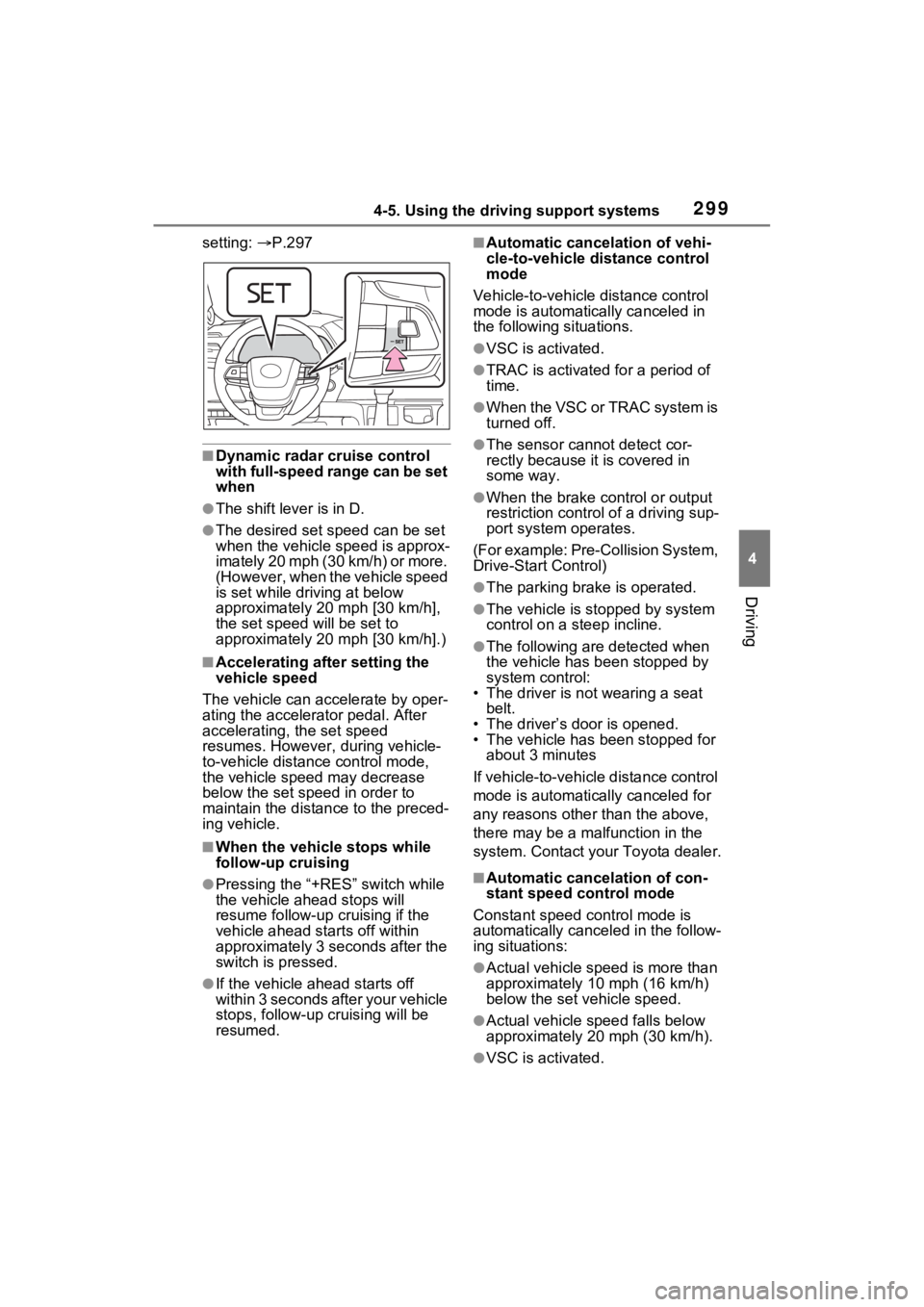
2994-5. Using the driving support systems
4
Driving
setting: P.297
■Dynamic radar cruise control
with full-speed range can be set
when
●The shift lever is in D.
●The desired set speed can be set
when the vehicle speed is approx-
imately 20 mph (30 km/h) or more.
(However, when the vehicle speed
is set while driving at below
approximately 20 mph [30 km/h],
the set speed will be set to
approximately 20 mph [30 km/h].)
■Accelerating after setting the
vehicle speed
The vehicle can accelerate by oper-
ating the accelerator pedal. After
accelerating, the set speed
resumes. However, during vehicle-
to-vehicle distance control mode,
the vehicle spee d may decrease
below the set speed in order to
maintain the distance to the preced-
ing vehicle.
■When the vehicle stops while
follow-up cruising
●Pressing the “+RES” switch while
the vehicle ahead stops will
resume follow-up cruising if the
vehicle ahead starts off within
approximately 3 seconds after the
switch is pressed.
●If the vehicle ahead starts off
within 3 seconds after your vehicle
stops, follow-up cruising will be
resumed.
■Automatic cancelation of vehi-
cle-to-vehicle d istance control
mode
Vehicle-to-vehicle distance control
mode is automatically canceled in
the following situations.
●VSC is activated.
●TRAC is activated for a period of
time.
●W h en t he V S C o r T RA C sys te m is
turned off.
●The sensor cannot detect cor-
rectly because i t is covered in
some way.
●When the brake control or output
restriction control of a driving sup-
port system operates.
(For example: Pre-Collision System,
Drive-Start Control)
●The parking brake is operated.
●The vehicle is stopped by system
control on a steep incline.
●The following are detected when
the vehicle has been stopped by
system control:
• The driver is not wearing a seat
belt.
• The driver’s door is opened.
• The vehicle has been stopped for about 3 minutes
If vehicle-to-vehicle distance control
mode is automatically canceled for
any reasons other than the above,
there may be a malfunction in the
system. Contact your Toyota dealer.
■Automatic cancelation of con-
stant speed control mode
Constant speed control mode is
automatically cance led in the follow-
ing situations:
●Actual vehicle speed is more than
approximately 10 mph (16 km/h)
below the set vehicle speed.
●Actual vehicle speed falls below
approximately 20 mph (30 km/h).
●VSC is activated.